Best Buy Mosquito Insect Repellant
Eco-Friendly Mosquito Killer Machine
- Electric Trap Lamp
- How does it work
- Six UV light bulbs emit around 370nm wavelength.
- This wavelength has a fatal attraction to insect mosquitoes.
- Mosquitos are attracted to the light source. After that, they will be trapped in the mosquito tray under a strong cyclone.
- A powerful cyclone will make the mosquito dehydrated and die.

- Advantages
- No radiation
- non-toxic and chemical-free
- is extremely silent
- Healthy and safe for all including children
USB Powered Electronic Mosquito Killer Bug Zappers
- USB Powered
- Mosquito Killer Bug Zappers
-
LED Mosquito Killer Machine Trap Lamp
-
Theory Screen Protector Mosquito Killer lamp
Repellant Cream
- Odomos is one of the best mosquito repellents endorsed by the NATIONAL INTEGRATED MEDICAL ASSOCIATION (NIMA).
- It is certified as safe to use by leading authorities in India
- It is highly effective against mosquitoes
- Odomos Mosquito Repellent Cream is well-tested to be safe even for babies

How to Prevent Mosquitos in the Home
- Preventing mosquitoes in and around your home involves a combination of environmental management, personal protection, and, if necessary, the use of mosquito control measures.
- Here are several strategies to help prevent mosquitoes from entering and breeding in your home:
Eliminate Standing Water:
- Mosquitoes breed in stagnant water. Regularly empty and clean containers that can collect water, such as flower pots, buckets, and bird baths.
- Fix leaks and ensure proper drainage to prevent the accumulation of water around your home.
Use Mosquito Screens:
- Install screens on windows and doors to keep mosquitoes out while allowing fresh air to circulate. Make sure there are no holes or tears in the screens.
Close Doors and Windows:
- Keep doors and windows closed, especially during peak mosquito activity times, which are typically dawn and dusk.
Install Mosquito Nets:
- Use mosquito nets over beds, especially if you live in an area where mosquito-borne diseases are prevalent.
Use Mosquito-Repellent Products:
- Apply mosquito repellent on exposed skin. Use repellents containing DEET, picaridin, or oil of lemon eucalyptus.
- Consider using mosquito-repellent lotions, sprays, or patches, particularly in areas with a high mosquito population.
Wear Protective Clothing:
-
- Wear long-sleeved shirts, long pants, socks, and closed shoes, especially in areas where mosquitoes are abundant.

Use Mosquito Traps:
-
- Consider using mosquito traps, such as electric mosquito zappers or traps specifically designed for indoor use.
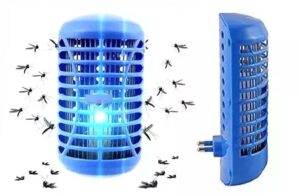
Keep the Surrounding Area Clean:
-
- Dispose of garbage properly to eliminate potential mosquito breeding sites.
- Trim vegetation and keep the area around your home clean and well-maintained.
Natural Mosquito Predators:
-
- Introduce natural predators of mosquito larvae, such as mosquito fish, in standing water bodies like ponds or ornamental pools.
Avoid Strong Scents:
-
- Mosquitoes are attracted to strong scents. Avoid using heavily scented products, such as perfumes and lotions, especially when spending time outdoors.
Use Mosquito-Repellent Plants:
-
- Plant mosquito-repelling plants around your home, such as citronella, lavender, basil, and mint.
Professional Pest Control:
-
- If mosquito infestations persist, consider seeking professional pest control services.
- They can provide targeted treatments to reduce mosquito populations.

Mosquito-Proof Your Home:
-
- Seal gaps and cracks in doors and windows to prevent mosquitoes from entering your home.
- Use mosquito nets or screens over cribs and beds, especially for infants and young children.

Fogging Machines for Mosquito Killing
- Fogging machines are commonly used as a method for mosquito control, especially in outdoor areas.
- These machines disperse a fine mist of insecticide into the air to kill adult mosquitoes.
- However, there are both advantages and considerations associated with the use of fogging machines for mosquito control:
Advantages:
- Effective for Adult Mosquitoes: Fogging is particularly effective in killing adult mosquitoes that are flying in the treated area during the application.
- Quick Results: Fogging can provide relatively quick results in reducing the adult mosquito population in a targeted area.
- Large Area Coverage: Fogging machines can cover large outdoor spaces, making them suitable for use in parks, residential areas, and other open environments.
- Rapid Application: Fogging is a relatively quick process, allowing for the efficient application of insecticides in a short period.
- Integrated Pest Management: Fogging can be part of an integrated pest management strategy when combined with other control measures.
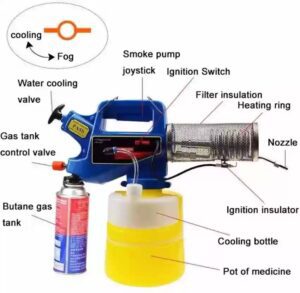
Considerations and Guidelines:
- Professional Application:
- Fogging is often conducted by professional pest control services or local health departments. It is essential to seek expert advice and assistance to ensure the appropriate use of insecticides and proper application techniques.
- Correct Insecticides:
- Use insecticides specifically designed for mosquito control. The choice of insecticide should consider the mosquito species in the area and their susceptibility to different chemicals.
- Timing and Weather Conditions:
- Conduct fogging during times when mosquitoes are most active, typically during dawn or dusk. Weather conditions, such as wind and rain, can affect the effectiveness of fogging.
- Avoid Overuse:
- Overuse of fogging can lead to resistance in mosquito populations, making them less susceptible to the insecticides.
- It’s important to use fogging as part of a comprehensive mosquito control plan.
- Safety Precautions:
- Follow safety guidelines and precautions when using fogging machines. Keep people and pets away from the treated area during and immediately after fogging. Use personal protective equipment as recommended.
- Community Awareness:
- Inform the community about the fogging schedule and the need for cooperation.
- Residents should take precautions, such as closing windows and doors during fogging, to minimize exposure.
- Environmental Impact:
- Consider the potential environmental impact of fogging. Be mindful of non-target organisms and ecosystems. Use environmentally friendly practices whenever possible.
- It’s important to note that fogging primarily targets adult mosquitoes and may not be effective in eliminating mosquito larvae or preventing future breeding. To address mosquito-borne diseases comprehensively, a combination of control measures, including source reduction, larviciding, and personal protection, should be implemented. Additionally, community engagement and awareness are crucial for the success of mosquito control efforts.
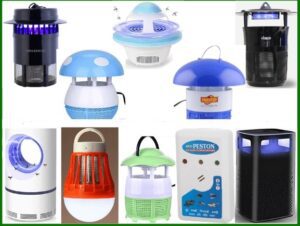
Electric Mosquito Killing Machines
- Electric mosquito-killing machines come in various forms and are designed to attract, trap, or electrocute mosquitoes and other flying insects.
- These are designed to trap, electrocute, or repel mosquitoes and other flying insects
- Here are some common types of electric mosquito-killing devices:
Electric Mosquito Zappers:
- These devices use ultraviolet (UV) light to attract mosquitoes and other flying insects.
- When the insects come into contact with an electrified grid, they are electrocuted.
- Zappers are typically used outdoors and should be placed away from areas where people gather.

Indoor Mosquito Traps:
-
-
- Indoor mosquito traps use a combination of attractants, such as UV light, heat, and sometimes carbon dioxide, to lure mosquitoes into a container.
- Once inside, mosquitoes are either trapped or killed using a fan, adhesive, or an electric grid.
-
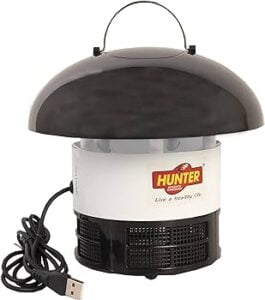
Electric Mosquito Swatters:
- Mosquito swatters are handheld devices resembling a tennis racket.
- They have an electrified grid that kills mosquitoes on contact when swatted. These are manual devices and are suitable for use indoors.
Mosquito Killing Lamps:
- Some lamps are designed to attract and kill mosquitoes using UV light.
- These lamps may have an adhesive surface or an electrified grid to capture or kill mosquitoes when they come into contact.
Mosquito Repellent Machines:
-
- Electric devices that release mosquito-repellent substances, such as citronella or synthetic repellents, into the air. While these devices don’t directly kill mosquitoes, they can help repel them from the immediate area.
When using electric mosquito-killing devices, consider the following tips:
- Placement: Position the device strategically in areas where mosquitoes are likely to be active. For example, place zappers outdoors, traps near areas where mosquitoes enter the home, and swatters in rooms where mosquitoes are a nuisance.
- Safety: Follow safety guidelines provided by the manufacturer. Keep devices out of reach of children and pets, and avoid placing them near flammable materials.
- Cleaning: Regularly clean and maintain the devices to ensure optimal performance. Empty and clean traps, replace adhesive surfaces, and clean electrified grids according to the manufacturer’s instructions.
- Compatibility with Other Measures: Electric mosquito-killing devices are most effective when used in conjunction with other preventive measures, such as eliminating breeding sites and using personal mosquito repellents.
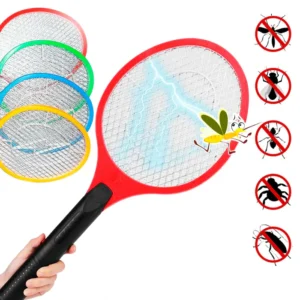
Electric Mosquito Bats
- An electric mosquito bat, also known as an electric mosquito swatter or fly swatter, is a handheld device designed to kill flying insects, including mosquitoes, on contact.
- These devices are popular for indoor use and provide a convenient and effective way to deal with mosquitoes and other flying pests.
- Here’s how electric mosquito bats typically work and some tips for using them:
How Electric Mosquito Bats Work:
- Design: Electric mosquito bats typically look like tennis rackets. They have a flat, electrified surface that acts as a grid.
- Electrified Grid: The surface of the bat is charged with a low electric current. When an insect comes into contact with the grid, it gets electrocuted, leading to its instant demise.
- Safety Mechanisms: Most electric mosquito bats come with safety features, such as a button or switch that needs to be pressed to activate the electrified grid. This helps prevent accidental shocks.
Guideline for Using Electric Mosquito Bats
- Safety Precautions:
- Follow the manufacturer’s safety instructions.
- Keep the bat away from water to avoid electrical hazards.
- Do not touch the electrified grid with bare hands.
- Usage:
- Swing the mosquito bat in the air to hit flying insects. The electric current is activated on contact.
- It’s more effective against mosquitoes in flight than those at rest.
- Charging:
- Electric mosquito bats are often rechargeable. Ensure that the bat is fully charged for optimal performance.
- Charging time and battery life vary depending on the model.
- Maintenance:
- Regularly clean the surface of the bat after use to remove insect remains.
- Keep the bat in a cool, dry place when not in use.
- Indoor Use:
- Electric mosquito bats are suitable for indoor use, especially in rooms with mosquitoes.
- Be cautious when using them around delicate items, as swinging too forcefully could cause damage.
- Not a Preventive Measure:
- While electric mosquito bats are effective for killing mosquitoes on contact, they don’t prevent mosquitoes or address the source of the problem.
- Combine their use with other preventive measures, such as eliminating standing water, using screens on windows, and using mosquito repellents.
- Keep Away from Children:
- Due to the electrified grid, electric mosquito bats are out of reach of children to prevent accidental shocks.
Conclusion
- By combining these preventive measures, you can create an environment that is less conducive to mosquito breeding and reduce the likelihood of mosquito-borne diseases.
- Consistent efforts to eliminate standing water and protect yourself from mosquito bites are key components of an effective mosquito prevention plan.
- Mosquito-killing devices can help reduce mosquito populations in specific areas, but they may not provide comprehensive control.
- Integrated pest management, including environmental control and personal protection measures, remains crucial for effective mosquito prevention.
- Electric mosquito bats are a handy tool for dealing with mosquitoes and other flying insects quickly. However, for comprehensive mosquito control, it’s essential to adopt a multi-pronged approach that includes eliminating breeding sites, using mosquito nets, and employing other preventive measures
